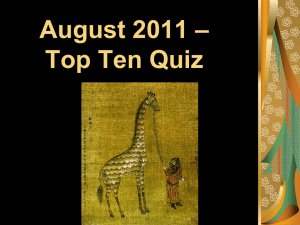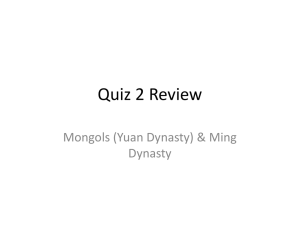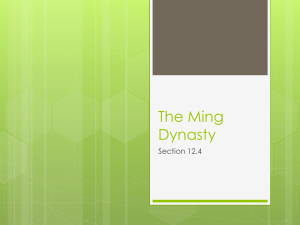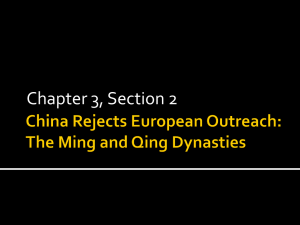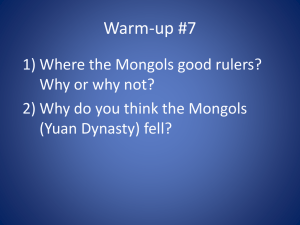Document A: The Great Wall of China
advertisement
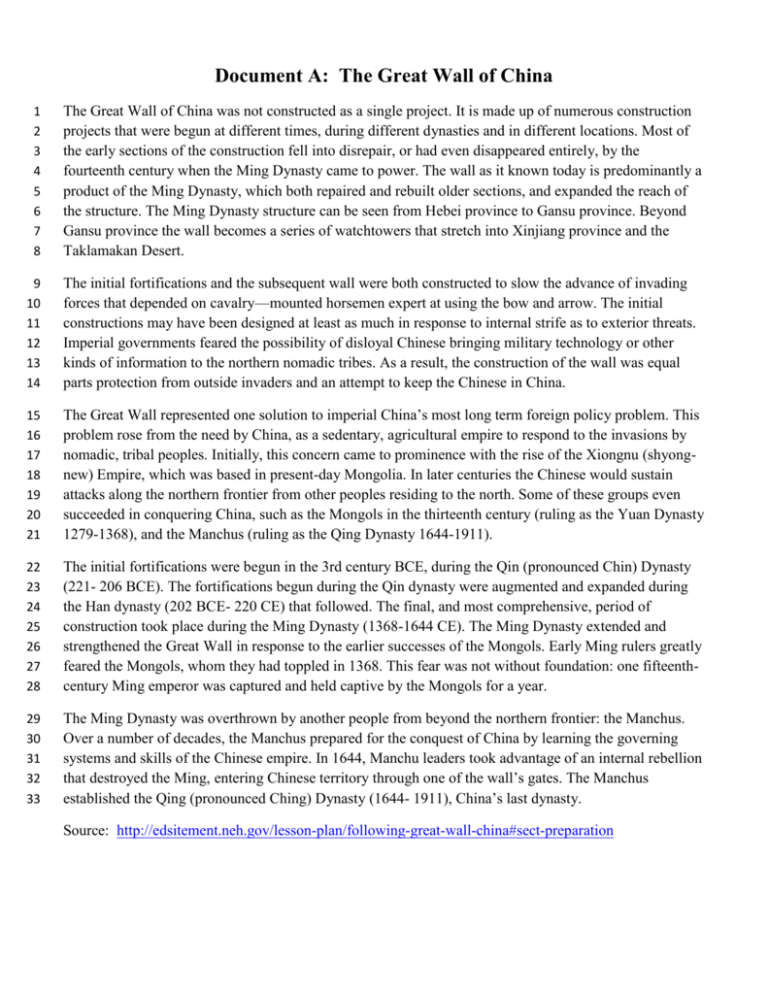
Document A: The Great Wall of China 1 2 3 4 5 6 7 8 The Great Wall of China was not constructed as a single project. It is made up of numerous construction projects that were begun at different times, during different dynasties and in different locations. Most of the early sections of the construction fell into disrepair, or had even disappeared entirely, by the fourteenth century when the Ming Dynasty came to power. The wall as it known today is predominantly a product of the Ming Dynasty, which both repaired and rebuilt older sections, and expanded the reach of the structure. The Ming Dynasty structure can be seen from Hebei province to Gansu province. Beyond Gansu province the wall becomes a series of watchtowers that stretch into Xinjiang province and the Taklamakan Desert. 9 10 11 12 13 14 The initial fortifications and the subsequent wall were both constructed to slow the advance of invading forces that depended on cavalry—mounted horsemen expert at using the bow and arrow. The initial constructions may have been designed at least as much in response to internal strife as to exterior threats. Imperial governments feared the possibility of disloyal Chinese bringing military technology or other kinds of information to the northern nomadic tribes. As a result, the construction of the wall was equal parts protection from outside invaders and an attempt to keep the Chinese in China. 15 16 17 18 19 20 21 The Great Wall represented one solution to imperial China’s most long term foreign policy problem. This problem rose from the need by China, as a sedentary, agricultural empire to respond to the invasions by nomadic, tribal peoples. Initially, this concern came to prominence with the rise of the Xiongnu (shyongnew) Empire, which was based in present-day Mongolia. In later centuries the Chinese would sustain attacks along the northern frontier from other peoples residing to the north. Some of these groups even succeeded in conquering China, such as the Mongols in the thirteenth century (ruling as the Yuan Dynasty 1279-1368), and the Manchus (ruling as the Qing Dynasty 1644-1911). 22 23 24 25 26 27 28 The initial fortifications were begun in the 3rd century BCE, during the Qin (pronounced Chin) Dynasty (221- 206 BCE). The fortifications begun during the Qin dynasty were augmented and expanded during the Han dynasty (202 BCE- 220 CE) that followed. The final, and most comprehensive, period of construction took place during the Ming Dynasty (1368-1644 CE). The Ming Dynasty extended and strengthened the Great Wall in response to the earlier successes of the Mongols. Early Ming rulers greatly feared the Mongols, whom they had toppled in 1368. This fear was not without foundation: one fifteenthcentury Ming emperor was captured and held captive by the Mongols for a year. 29 30 31 32 33 The Ming Dynasty was overthrown by another people from beyond the northern frontier: the Manchus. Over a number of decades, the Manchus prepared for the conquest of China by learning the governing systems and skills of the Chinese empire. In 1644, Manchu leaders took advantage of an internal rebellion that destroyed the Ming, entering Chinese territory through one of the wall’s gates. The Manchus established the Qing (pronounced Ching) Dynasty (1644- 1911), China’s last dynasty. Source: http://edsitement.neh.gov/lesson-plan/following-great-wall-china#sect-preparation Document B: The Great Wall of China 1 2 3 4 The complexity and sheer size of the Ming wall outdid all of its predecessors. Not only did the dynasty add length, it also added double and triple walls in some places to reinforce previously built structures and confuse attackers. In fact, in many places the wall is wide enough on top for someone to drive a car on it, averaging an impressive 22 feet (6.7 meters). … 5 6 7 8 9 10 11 The Ming Dynasty also increased the military prowess around the wall. Fortresses were placed intermittently along the length of the wall to store military supplies, and beacons were built to provide much-needed light. Another innovation to the wall that the Ming Dynasty introduced was guards. Guard towers were erected at strategic points along the wall from which guards would send out smoke signals and fire cannons to notify each other of possible hostile attacks. The only major downfall to these guard towers is that they were manned by humans, who sometimes fell prey to enemies' bribes and allowed them access to the other side of the wall. 12 Under the Ming,...defense of the known seems to have suited [them] better than exploration or progress. 13 14 15 16 The Ming were aware of the other civilizations in the world, to an extent previous dynasties had not been. By being so rigid and conservative, by not learning from the Europeans and taking the best elements of other cultures and adapting them to China, the Ming rulers kept China from developing, and therefore weak and defenseless. Sources: http://adventure.howstuffworks.com/great-wall-of-china2.htm and http://www.yourchildlearns.com/china_history_geography.htm Document C: Great Wall Map
